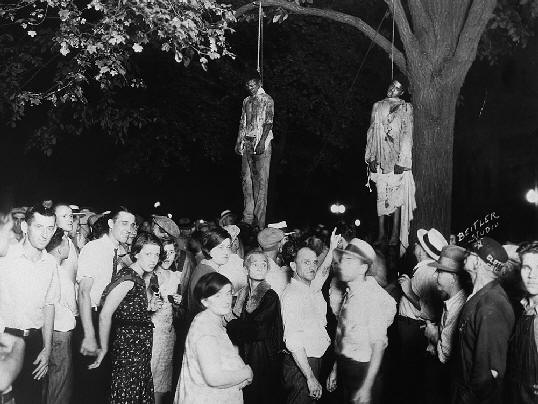A Lynching in the Heartland: Race and Memory in the Heartland by James H. Madison
An important look at a terrible act
On August 7, 1930 a crowd of hundreds, possibly thousands swarmed around the Grant County Court House in Marion, Indiana with the intent to remove three black teenagers and kill them by hanging from the trees on the Court House lawn - a lynching. Two of the young men were lynched, the third was spared for reasons that no one seems to remember. The survivor claims it was a miracle that he was released and put back into the jail, and it may well have been so. Nevertheless, it may have mostly disappeared from America's collective memory except as an aberration from the stereotypical norm of lynchings being a mostly Southern phenomenon.
That is, it may have been forgotten except for the picture taken by a local photographer named Lawrence Beitler who printed off hundreds of copies and sold them to gawkers the next day. Those copies made their way across the state and eventually across the world to be reprinted in newspapers, magazines, textbook and even in movies. The Beitler print is the iconic photo of a lynching. Two young men hang dead while a crowd of onlookers gawk. An angry man points. A husband and his pregnant wife hold hands and smile as though a lynching were as much fun as the county fair. Old men and old women stand and stare - one old woman uses the occasion to people watch. The surreality is striking and disturbing.
 | ||
| The lynching of Tom Shipp and Abe Smith. August 7, 1930 - Marion, Indiana |
James H. Madison's A Lynching in the Heartland: Race and Memory in the Heartland is more than a look at that one awful night. He puts it in context. He discusses lynching throughout the country, looks at the history of Grant County and its history of race relations and what he refers to as the ever-shifting "color line" - those unnamed rules of proper relations between blacks and whites in America as a whole and in Grant Country in particular.
Madison does not try to portray the victims of the lynch mob as martyred saints, nor does he demonize white Hoosiers. There are heroes and villains in the book, to be sure but they come as individuals, not in racial groups. This is not a case of the Ku Klux Klan rolling into town and killing two young man (the KKK was mostly disgraced and defunct in Marion after many statewide scandals despite having had a popular run a few years before). Nor is it the case of a consistently intolerant city just doing what came naturally. Madison shows us the frustrating nuances that make this a complicated piece of history.
Madison follows the city through the 1940s and into the Civil Rights era of the 50s, 60s and 70s to the turn of the 21st century. Real racial progress was made, in fits and starts. But, always looming in the background was the awful image of Beitler's photograph...
Truly a remarkably well-written and deftly handled history.
I rate this book 5 stars out of 5.
This book can be found on Amazon.com here: A Lynching in the Heartland.
Reviewed on August 1, 2011.










Comments
Post a Comment